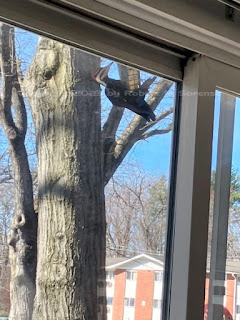Pileated Woodpecker Surprises
by Cowboy Bob Sorensen
This is one of those times I must refrain from writing in character; no Darwin Ranch folks. Y'all have read how my wife and I have grown to appreciate birds in our area. She likes to provide seeds, and frequently shelled unsalted peanuts (especially for Blue Jays). The suet feeder, a small basket-like apparatus, is for the woodpeckers.
In our area, we see the Downy Woodpecker most often, and occasionally the larger version, the Hairy, stops by to peck at the suet cake. So does the Red-Bellied, which is about the same size as the Hairy. And boy, do they peck! Sparrows are winged pigs, but the others usually chase them off. (The Northern Flicker made it to the porch a couple of times, but I disremember if those like suet.) We wistfully thought about how great it would be if the Pileated stopped by, but it's a big bird and this is an apartment complex.
Downy caps at about seven inches (18 cm.) and is quite comfortable on the suet feeder. Hairy can be 10 inches (26 cm.) and uses its tail to hang onto the feeder. Same with the Red-Bellied. The Pileated (old word referring to the red crest) reaches nineteen inches (49 cm.) long, almost double the size of Hairy and Red-Bellied. We looked it up, and yes, they like suet feeders too, but need special accommodations because of their size. Or get a bigger feeder. Neither works for us because squirrels are relentless eating machines.
My wife told me about seeing one in nearby trees across the driveway (we refer to it as a street since it's the size of streets in the area). I was pleased to see a Pileated on the nearest tree across the street doing some excavation — they really dig in and make tremendous holes if they've a mind to. The digging is for finding food and for nesting. It's interesting to watch them stop and move their heads to the left and to the right, looking and listening. People who know woodworking have said that they have great skill for choosing angles and such.
While I was working on this here laptop and listening to something in the headphones, my wife made almost incomprehensible noises. I realized she wanted me to pay attention, that Mrs. Pileated was on the tree closest to our apartment (the same tree in the picture). How cool is that? I leaned over in the chair to get a better look; one simply does not walk to the window and expect the rare bird to stay put. |
| Mrs. Pileated Woodpecker at our suet feeder in the apartment complex |
As I was watching and admiring, I made a strange wheezing, gasping noise as that thirty-inch wingspan was unfurled. She flew from the tree toward us and landed on the feeder! We thought such a thing would never happen. My wife had the best vantage point, but was only able to get pictures with her phone camera. The window screen detracts from the pictures. Neither of us wanted to get closer and risk scaring her away. But she made four visits to the feeder, so my wife obtained several shots. You can see how the woodpecker used her tail for leverage.
 |
| Note how Mrs. Pileated uses part of her tail to hold the feeder |
More than that, however, is that we can see the work of the Master Engineer. Centuries ago when I was giving biblical creation science talks, one subject I shared was woodpeckers. They are marvelous examples of specified complexity. Not only do they take their sharp beaks and dig into wood, they use them for drumming — a method of signaling.
"They have reinforced sharp beaks, I get that, Cowboy Bob. But they shouldn't live through that!"
Here's the specified, irreducible complexity coming into focus. The skull is reinforced and has shock absorbing capabilities. But the noise! Whether digging in or drumming, insects will hear the noise or feel the vibrations and back off. The Creator gave the woodpecker an extra long tongue with barbs on the end, and it is sticky so it can pick up its food that way. The tongue has a special storage place inside the skull and sometimes is tucked all the way around into the right nostril; design with a touch of humor?
While there would be some natural selection involved, the Creator has implemented several evolution-defying features in them. They have to be in place at the same time, else nothing works, nothing makes sense. Biblical creation science helps me appreciate living things in a deeper way than I would have. By the way, totally unscientific, but I think the Pileated surprises were a blessing directed toward my wife who needed it at that time.